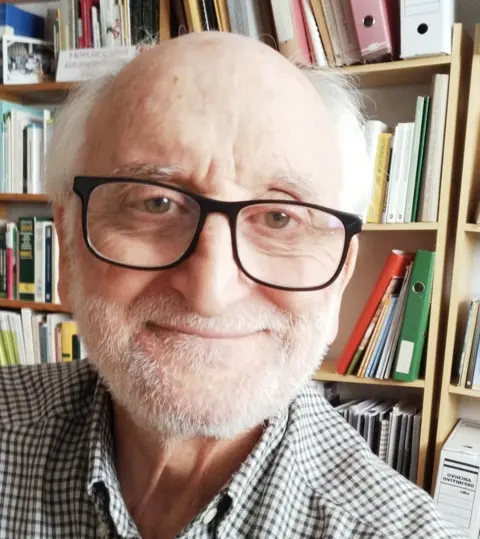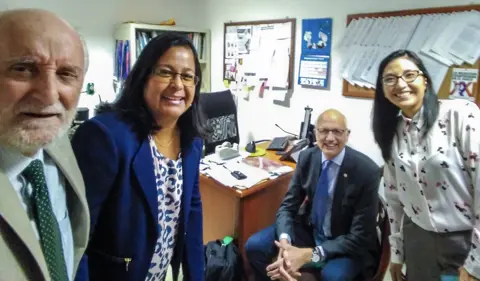
Uppsala Reports editor
@UMCGlobalSafety

Group shot of the first cohort to take the UMC course on pharmacovigilance in 1993
This year marks the 30th anniversary of pharmacovigilance courses offered by Uppsala Monitoring Centre. To celebrate this milestone, we reached out to Mariano Marduga, one of the very first participants to take our course in 1993 to reflect on his experience and how it has impacted his career since.
Can you first tell us a bit more about yourself and your involvement in pharmacovigilance over your career?
Firstly, thank you for offering me this opportunity to share my professional experiences in pharmacovigilance. It is a source of pride to be able to review more than 40 years of work focused on public health and on drug safety.
I began my career as a pharmacy graduate of the Universidad Complutense of Madrid in 1973. My initial work was as a drug information specialist in various capacities: for a pharmacotherapy journal (Mundo Farmacéutico), developing courses for community pharmacists, and creating the first Drug Information Centre (DIC) in Spain at the College of Pharmacists of Madrid in 1982. Pharmacovigilance became more established in Spain in 1983 with the commencement of the Spanish Pharmacovigilance System (SEFV), and in 1984 Spain officially joined the WHO Programme of International Drug Monitoring (PIDM). It was in 1986 that I shifted to pharmacovigilance, joining the Ministry of Health at the Carlos III Health Institute (ISCIII) as an official. Since 1990, the coordination of the SEFV moved from Barcelona to the ISCIII in Madrid. As such, I have participated in the development and implementation of the Farmacovigilancia Española, Datos de Reacciones Adversas (FEDRA), the Spanish pharmacovigilance database, based on all the ICSRs collected since 1983. This motivated my additional training in pharmacovigilance and pharmacoepidemiology, which is why I took the UMC course in 1993, as well as training carried out from 1992 to 1996 at the Autonomous University of Barcelona. I also participated as a member of the Telematic Implementation Group at the European Medicines Agency (EMA), during the development of the European EudraVigilance database. From 1999 until my retirement in January 2017, I worked at the Spanish Agency for Medicines and Health Products (AEMPS). At AEMPS I have coordinated the development and implementation of the SEFV. The SEFV is a unique model in which 17 regional centres have all their information stored in the FEDRA database that is managed by the AEMPS pharmacovigilance unit. These centres participate in the generation and management of PV signals, in turn, coordinated between the 27 European national agencies through the Pharmacovigilance Risk Assessment Committee at the EMA.
An important part of my career in pharmacovigilance has been teaching. Since the 90s I have participated in different pharmacovigilance collaborations such as the creation of the pharmacovigilance system in Venezuela and Cuba. From 2000 onwards, in collaboration with Ibero-American countries as part of the EAMI Network (RedEAMI.net), I have developed dozens of courses on pharmacovigilance and drug regulation in the three training centres owned by the Spanish Agency for International Development Cooperation (AECID) in the Americas (Cartagena in Colombia, Santa Cruz in Bolivia, and Antigua in Guatemala). In 2011, a support agreement was signed between AEMPS and the Executive Secretariat of the Council of Ministers of Health of Central America to use the SEFV as a model to establish a similar system in the Central American region (comprising eight countries), with the new Farmacovigilancia Centroamericana, Datos de Reacciones Adversas (FACEDRA) database, and the e-reporting system, Noti-FACEDRA.
Since my retirement in 2017, I continue my work as a pharmacovigilance consultant and participate as a teacher in the “Master in Pharmacoepidemiology and Pharmacovigilance”, at the University of Alcalá de Henares (Madrid, Spain), among other collaborations. I'm still "pharmacovigilant"!!
How was it to practise pharmacovigilance and conduct pharmacovigilance research at that time?
In the 1990s, pharmacovigilance work began utilising technology like smart PCs and fax machines to send documents, which made it easier to access subscriptions to paper bulletins on drug safety published by regulatory agencies, or by publishers such as the Reactions Weekly (ADIS Press) in collaboration with UMC. I remember with gratitude the use of the Iowa Drug Information Service, a magnificent drug information tool from the University of Iowa (USA), that when it began in 1965, was stored on microfiche, and later became a web-based database until 2015 when it was closed. The domestic creation of the FEDRA database in 1990 facilitated the management of ICSR information in Spain. Every 2-3 months new ISCRs were downloaded as TXT files that were sent on diskettes to UMC. However, the communications between the Spanish regional centres and this central database involved slow transmission protocols. While the creation of the internet allowed for the management of FEDRA information in a web environment from the end of 1999, many tasks were still paper-based, such as drug utilisation studies. Teamwork in the SEFV was conducted through face-to-face meetings of the Technical Committee, as well as meetings of the National Pharmacovigilance Commission in the Ministry of Health and of AEMPS with minutes distributed by fax to the members afterwards. We used statistical packages such as Epi-Info for our analyses. Information technology (IT) has come a long way in these last 30 years. Paper has been eliminated, and connections between people and between databases have been optimised with web service APIs.

“This course has helped me broaden my vision of pharmacovigilance and has allowed me to form professional relationships with colleagues from other countries.”
How did you first find out about the UMC course? Were there other institutions offering such courses back then?
As Spain has been a member of the WHO PIDM since 1984, and as a national centre of the SEFV since 1990, AEMPS has received regular information on the activities through the UMC communication forum, Vigimed (a web platform set up by UMC to stimulate discussions and facilitate the rapid exchange of information between national centres). So, when the development of the SEFV regional centres was still in its beginnings, it was deemed necessary to train team members. That is the reason why I took the UMC course in 1993, as well as a master's degree in pharmacovigilance and pharmacoepidemiology at the University of Barcelona from 1992 to 1996.
What made you decide to take the course?
I took the course as it covered the basic aspects of pharmacovigilance but also elaborated on the structure of the international PIDM program. It also allowed me to network with other pharmacovigilance scientists from other countries, who were beginning, like us in Spain, to create their national systems.
Considering how long ago you took the course, is there an experience or memory related to the course that has stayed with you over these last three decades?
The greatest memory of that course was visiting the beautiful and peaceful city of Uppsala for the first time. I remember it was September and one day it rained. A few days after finishing the course, Sten Olsson (RIP) wrote to us saying that it had already snowed in Uppsala and that this snow was going to remain on its streets until the following spring. From those days in Uppsala, I also remember with joy how I met my colleague from Mexico, Dr Carmen Becerril, and from Morocco, Dr Rachida Soulaymani, with whom I have remained great friends over the years.
How has the course impacted or helped you in your pharmacovigilance career since then?
This course has helped me broaden my vision of pharmacovigilance and has allowed me to form professional relationships with colleagues from other countries which has led to collaborations on different pharmacovigilance tasks in each of our fields.

Thinking back on your career, what is one piece of advice you would have liked your younger self to have known back then?
My advice: improve your level of English to be bilingual. I have always had a handicap which has been my level of English, aggravated by my permanent tinnitus, which has prevented me from communicating properly with my colleagues. I have personally tried to compensate for this lack with my contribution as a translator from English to Spanish of more than 20 UMC and WHO publications on pharmacovigilance. Prof Edwards once called me the "translator pharmacovigilant". One such example is the book "Expecting the Worst" (2nd edition, 2010), which I in collaboration with UMC translated from English to Spanish. It took almost 10 years of work for its translation, sponsored by the Mexican Association of Pharmacovigilance and other collaborators, until its final edition in 2018.
What do you think the future holds for education on pharmacovigilance?
Since the autumn of my professional life, I have seen that IT and artificial intelligence are going to necessitate a change in terms of training and further development of pharmacovigilance as a field. Distance self-learning (e-learning) will become a standardised practice, and pharmacovigilance tasks will be increasingly automated with the handling of real-world data, such as clinical records, and will require constant updating in clinical pharmacology and biotechnological medicines. All this will motivate a specialisation in the different phases of risk analysis and management to form multidisciplinary teams to work more closely together.
BoMRA have taken a significant step to better manage AEFI reporting with a training programme that aims to empower them to train their staff and HCPs.
13 June 2024
As younger generations look to social media for guidance, both medical and otherwise, should health literacy became a part of the school curriculum?
30 October 2025
Working together with students on their signal assessments made clear to teachers the challenges that national centres face in their pharmacovigilance work.
25 August 2023